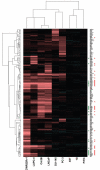DNA hypomethylation arises later in prostate cancer progression than CpG island hypermethylation and contributes to metastatic tumor heterogeneity
- PMID: 18974140
- PMCID: PMC2577392
- DOI: 10.1158/0008-5472.CAN-07-6088
DNA hypomethylation arises later in prostate cancer progression than CpG island hypermethylation and contributes to metastatic tumor heterogeneity
Abstract
Hypomethylation of CpG dinucleotides in genomic DNA was one of the first somatic epigenetic alterations discovered in human cancers. DNA hypomethylation is postulated to occur very early in almost all human cancers, perhaps facilitating genetic instability and cancer initiation and progression. We therefore examined the nature, extent, and timing of DNA hypomethylation changes in human prostate cancer. Contrary to the prevailing view that global DNA hypomethylation changes occur extremely early in all human cancers, we show that reductions in (5me)C content in the genome occur very late in prostate cancer progression, appearing at a significant extent only at the stage of metastatic disease. Furthermore, we found that, whereas some LINE1 promoter hypomethylation does occur in primary prostate cancers compared with normal tissues, this LINE1 hypomethylation is significantly more pronounced in metastatic prostate cancer. Next, we carried out a tiered gene expression microarray and bisulfite genomic sequencing-based approach to identify genes that are silenced by CpG island methylation in normal prostate cells but become overexpressed in prostate cancer cells as a result of CpG island hypomethylation. Through this analysis, we show that a class of cancer testis antigen genes undergoes CpG island hypomethylation and overexpression in primary prostate cancers, but more so in metastatic prostate cancers. Finally, we show that DNA hypomethylation patterns are quite heterogeneous across different metastatic sites within the same patients. These findings provide evidence that DNA hypomethylation changes occur later in prostate carcinogenesis than the CpG island hypermethylation changes and occur heterogeneously during prostate cancer progression and metastatic dissemination.
Figures






References
-
- Feinberg AP, Vogelstein B. Hypomethylation distinguishes genes of some human cancers from their normal counterparts. Nature. 1983;301:89–92. - PubMed
-
- Esteller M, Corn PG, Baylin SB, Herman JG. A gene hypermethylation profile of human cancer. Cancer Res. 2001;61:3225–9. - PubMed
-
- Jones PA, Laird PW. Cancer epigenetics comes of age. Nat Genet. 1999;21:163–7. - PubMed
-
- Karpf AR, Matsui S. Genetic disruption of cytosine DNA methyltransferase enzymes induces chromosomal instability in human cancer cells. Cancer Res. 2005;65:8635–9. - PubMed
Publication types
MeSH terms
Grants and funding
LinkOut - more resources
Full Text Sources
Other Literature Sources
Medical
Molecular Biology Databases

